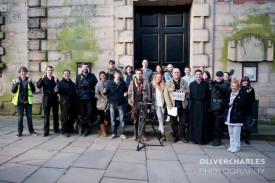
Filmmaking is all about teamwork. But sometimes DPs can forget this and ignore the needs of other departments in their quest to get their perfect shot. In recent years I’ve really come to appreciate the importance of forging a good relationship with the other heads of department so as to get the best possible results and foster a good vibe on set.
Take cross-lighting as an example. Cross-light comes in from the side of frame and throws any texture into relief. This might be exactly what you need to show off the detail in a set or a costume and make the art department very happy. Or it might show up things we don’t want to see – the edge of a make-up appliance, or scarring on an actress’s face. In cases like this, a good DP should modify their lighting, no matter how much they love it, so that the make-up or the talent looks their best.
I’d like to collaborate more with make-up artists in the future. I’m sure we’re looking at a lot of the same things when we assess a face and decide how to approach it. Understanding the direction the make-up is going in could spark ideas about how to build on that with light. I once spent a lot of time trying to lighten up the face of an actor who had been made-up very dark; a brief chat with the MUA beforehand could have avoided that wasted time.
Stanley Kubrick’s production designer apparently used to design sets with a master shot in mind. So when you walk onto a set or a dressed location, talk to the designer about where they think it looks best from. They have lived with this set for longer than you have and they may have some great ideas.
It’s also important to respect others’ work. Don’t walk onto a set and start dressing stuff to camera; show the designer the monitor and let them work their magic. And don’t move stuff to get your tripod in without asking permission; they may need to take continuity pictures first so that they can put everything back in the right place later.

The same goes for the sound department. If the boom op is struggling with shadows, tweak the lighting to help them out if you can. No film set is complete without a friendly rivalry between the camera and sound departments, but it’s vital this is underpinned by mutual respect. Sometimes there is an attitude on set that the DP outranks the sound recordist; don’t tolerate this. Sound and vision are equally important.
Last but definitely not least is the cinematographer’s relationship with the talent. It’s easy to forget how much important work is going on in an actor’s head. And what are the crew doing while the cast are trying to focus? Cracking jokes, spraying smoke around, turning on dazzling lights, thrusting polyboards in people’s faces, clapping slates and generally being incredibly distracting. Try to be aware of this and minimise it where possible, particularly for very serious or emotional scenes. Explain to the talent why you’re surrounding them with equipment and how it’s making them look good and servicing the story. Foster an environment where they feel they can ask you to move something if it’s distracting. If the acting isn’t good, no-one is going to watch the film long enough to admire the lighting – so do what you can to help the talent.
And remember, when people view your showreel, they’re judging not just the quality of your work, but the overall quality of the films you’ve worked on. In short, help make other people look good and you will look good too.